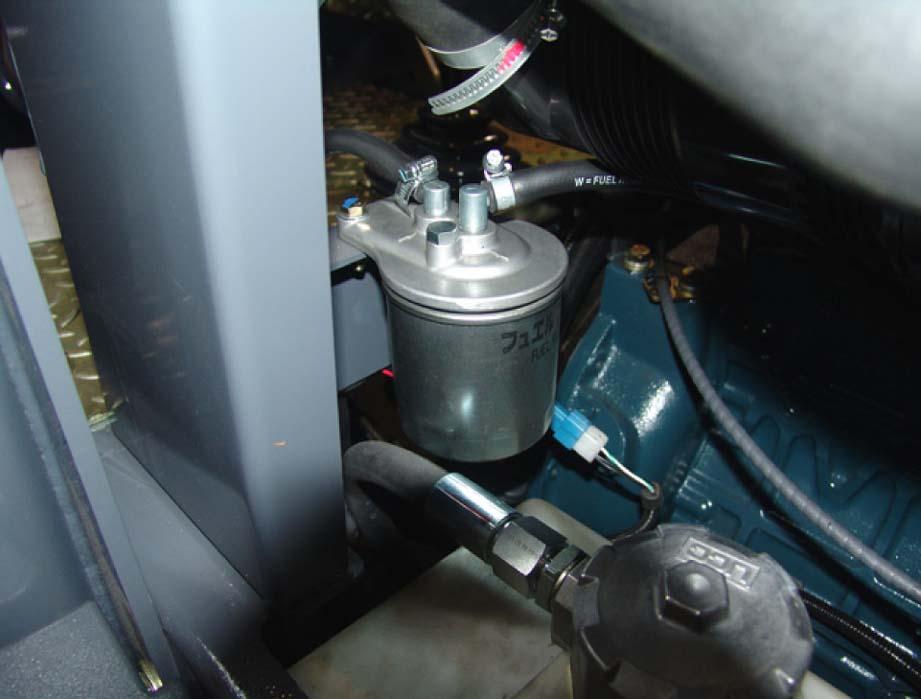SERVICE MANUAL
Foreword
The Operator's Manual
You and others can be killed or seriously injured if you operate or maintain the machine without first studying the Operator's Manual. You must understand and follow the instructions in the Operator's Manual. If you do not understand anything, ask your employer or JCB dealer to explain it.
Do not operate the machine without an Operator's Manual, or if there is anything on the machine you do not understand.
Treat the Operator's Manual as part of the machine. Keep it clean and in good condition. Replace the Operator's Manual immediately if it is lost, damaged or becomes unreadable.
03 - Outer Element
Clean 15-58
Remove and Install 15-59
Clean
1.Make the machine safe.
2.Get access to the air filter.
3.Clean the area around the air cleaner.
4.The dust ejector should be squeezed to release any build up of dust in the air cleaner case before removing the elements Refer to Figure 94.
A Sediment cup
C Inner element
E Dust ejector
5.Loosen the clamps holding the sediment cup to the air cleaner body and pull cup clear. Refer to Figure 94.
6.Pull out the outer element from the body.
6.1.Clean the outer element by tapping gently on a firm object or by blowing gently with compressed air from inside the element. Refer to Figure 94.
6.2.Replace the outer element, if it is damaged or severely contaminated.
7.Do not clean the inner element.
7.1.Replace the inner element, if it is contaminated.
8.Clean the outer body and sediment cup.
9.Assemble the cleaner.
B Outer element
D Body
F Clamp
Remove and Install
Remove
1.Make the machine safe. Refer to (PIL 01-03).
2.Isolate the battery. Refer to (PIL 33-03).
3.Open the air cleaner end cap clips (x2).
4.Remove the air filter assembly end cap.
Install
1.The installation procedure is the opposite of the removal procedure.
A End cap clips (x2)
B Air filter assembly end cap
5.Remove the outer air filter element.
C Outer air filter element
6.Remove the inner air filter element.
D Inner air filter element
00 - General Introduction
Flywheels are used to provide continuous energy in systems, where the energy source is not continuous. In such cases, the flywheel stores energy when torque is applied by the energy source, and it releases stored energy when the energy source is not applying torque to it.
In a reciprocating engine, a flywheel is used to maintain constant angular velocity of the crankshaft.
The flywheel, which is mounted on the crankshaft, stores energy when torque is exerted on it by a firing piston, and it releases energy to its mechanical loads when no piston is exerting torque on it.
12 - Drive Plate
Remove and Install
Remove
1.Make the machine safe. Refer to: PIL 01-03-27.
2.Isolate the battery. Refer to: PIL 33-03.
3.Remove the wheel drive pump. Refer to: PIL 27-31-00.
4.Remove the bolts 1 (x8).
5.Remove the adaptor plate.
Install
1.The installation procedure is the opposite of the removal procedure. Additionally do the following step.
2.Tighten the bolts to the correct torque value. Table 29. Torque Values
A Adaptor plate
B Bolts 1 (x8)
6.Remove the bolts 2 (x6).
7.Remove the drive plate.
C Bolts 2 (x6)
D Drive plate
00 - General
Introduction
The electric starter motor is either a permanentmagnet or a series-parallel wound direct current electric motor with a starter solenoid mounted on to it. When the current from the battery is applied to the solenoid, through the key-operated ignition switch, the solenoid engages a lever that pushes out the drive pinion on the starter driveshaft and meshes the pinion with the starter ring gear on the flywheel of the engine.
Thesolenoidalsocloseshighcurrentcontactsforthe starter motor, which begins to turn. Once the engine starts, the key-operated ignition switch is opened, a spring in the solenoid assembly pulls the pinion gear away from the ring gear, and the starter motor stops.Thestartermotorpinionisclutchedtothedrive shaft through an overrunning clutch which permits thepiniontotransmitdriveinonlyonedirection.Drive is then transmitted through the pinion to the flywheel ring gear, but if the pinion remains engaged (as for example because the operator fails to release the key as soon as the engine starts, or if there is a short and the solenoid remains engaged), the pinion will spin independently of the drive shaft, this prevents the engine driving the starter.
The starter motor is only designed for intermittent use, the electrical components are designed only to operate for a time period of 20 s before overheating.
Health and Safety
WARNING Make the machine safe before working on it. Park the machine on level ground and lower the loader arm. Stop the engine and remove the ignition key. Make sure the park brake is engaged. Disconnect the battery to prevent the engine being started. Block all four wheels.
Notice: Before carrying out arc welding on the machine, disconnect the battery and alternator to protect the circuits and components. The battery must still be disconnected even if a battery isolator is installed.
Notice:Donotisolatethemachineelectricswhen the engine is running, this may cause damage to the machine electrics.
A Solenoid positive terminal (From battery)
C Negative terminal (To ground)
B Solenoid terminal (From ignition switch)
D Solenoid positive after contact terminal (To motor)
Check (Condition)
Before carrying out the multimeter tests, check the battery condition and make sure that all the applicable electrical connections are clean and tight. Make sure that the starter motor fixing bolts are tightened to the correct torque.
To prevent the engine starting during the tests make sure that the applicable engine stop fuse is removed. Check the readings in the following sequence using a multimeter. Unless otherwise stated, the readings must be taken with the ignition switch held in the start position (HS) and the controls set to enable the starter motor. The readings are shown for both 12 V and 24 V systems. The highest values are for machines with 24 V systems. Identify the applicable system before carrying out the tests.
Do not operate the starter motor for more than 20 s at one time. Let the starter motor cool for at least 2 min between starts.
1.Connect the multimeter across the battery terminals.
A Starter main terminal
B Commutator end bracket (Starter earth connection)
2.1.Minimum permissible reading in start position
Voltage: 9 V
Voltage: 17 V
2.2.If the reading is within this limit, continue to 3. If the reading is outside the limit, proceed to 4
3.Connect the multimeter between the solenoid terminal and a good earth. Minimum permissible reading in start position
Voltage: 8 V
Voltage: 16 V
1.1.Reading in start position approximately
Voltage: 10 V
Voltage: 20 V
1.2.Minimum permissible reading in start position
Voltage: 9.5 V
Voltage: 18 V
1.3.A low reading probably indicates a fault in the starter motor.
2.Connect the multimeter between the starter main terminal and the commutator end bracket. In the start position, the reading should not be below the reading obtained in 1 by any more than
Voltage: 0.5 V
Voltage: 1 V
C Solenoid terminal
4.If the reading is less than specified, connect the multimeter between the start relay switched output and earth. A fault is indicated with the wiring from the start relay to the solenoid if the reading increases to
Voltage: 8 V
Voltage: 16 V
A Starter main terminal
B Starter earth connection
C Solenoid terminal
D Start relay feed
E Start relay switched output
H Battery positive and solenoid connection
4.1.If the reading is less than specified, connect the multimeter between the start relay feed and earth.
4.2.A faulty start relay or a fault in the feed to the relay solenoid is indicated if the voltage increases to
Voltage: 8 V
Voltage: 16 V
4.3.Check also the solenoid earth connection. The fault must be in either the starter switch orinthewiringbetweenthesolenoid,starter switch, and the start relay, if the reading between terminal and earth is less than
Voltage: 8 V
Voltage: 16 V
5.Connect the multimeter between battery negative and starter earth connection. The reading in the start position should be practically zero, maximum permissible reading
Voltage: 0.25 V
5.1.If the reading is above the maximum permissible voltage, a high resistance in the earth lead or connections is indicated.
6.Connect the voltmeter between battery positive and the starter main terminal. With the starter switch off, the voltmeter should indicate battery voltage, but it should fall to practically zero when the switch is turned to the on position, maximum permissible reading
Voltage: 0.25 V
B Starter earth connection
A Starter main terminal
7.If the reading is above the maximum permissible voltage, a high resistance is present in the insulated lead or in the solenoid. Connect the multimeter between the battery positive and solenoid connection. If the multimeter now reads zero with the switch closed, the fault is in the solenoid.
H Battery positive and solenoid connection
8.Finally install the engine stop fuse.
Remove and Install
Remove
1.Make the machine safe.
Refer to: PIL 01-03-27.
2.Isolate the battery.
Refer to: PIL 33-03.
3.Remove the floor plate. Refer to: PIL 09-78-00.
4.Remove the cable ties.
Figure 116.
Z Battery positive cable AA Starter solenoid connector
8.Remove the lower retaining bolt.
W Cable ties (x2)
5.Put a label on the electrical connectors to help installation.
6.Remove the battery positive cable cover.
Figure 117.
Y
Y Cable cover
7.Disconnect the battery positive cable and the starter solenoid connector.
A
A Lower retaining bolt
9.Remove the upper retaining bolt.
Figure 120.
B Upper retaining bolt
10.Disconnect the electrical connector.
Install
1.The installation procedure is the opposite of the removal procedure. Additionally do the following step.
2.Tighten the nuts to the correct torque value.
06 - Brush Gear
Remove and Install
The starter motor brushes are an integral part of the starter motor.
This part is a non-serviceable part if it fails, replace the complete starter motor.
00 - General
Introduction
Thefueltankisasafecontainerforstoringflammable fluids, from here the fuel is pumped into the engine.
There can be condensation in a partially filled fuel tank. Therefore, you must fill the fuel tank after you operate the engine.
Drain the water and sediment from any fuel storage tank at the recommended service intervals.
Remove and Install
CAUTION This component is heavy. It must only be removed or handled using a suitable lifting method and device.
Obey all fuel system health and safety information when working on the fuel system. Refer to: PIL 18-00-00.
Remove
1.Make the machine safe. Refer to: PIL 01-03-27.
2.Isolate the battery. Refer to: PIL 33-03-00.
3.Remove the drive control cable from the reaction bracket.
Figure 127.
Figure 129.
B
B Electrical connectors 1
6.Disconnect the electrical connectors 2.
7.Remove the screws and remove the clamps.
8.Reposition the harness.
Figure 130.
T Drive control cable
V Reaction bracket
4.Remove the cable ties.
Figure 128.
E Electrical connectors 2
F Screws
G Clamp
H Harness
9.Disconnect the fuel spill hose and the fuel supply hose.
Figure 131. J
A Cable ties
5.Disconnect the electrical connectors 1.
J Fuel spill hose
K Fuel supply hose
10.Remove the bolt 1 from the retaining bar.
11.Remove the retaining bar.
Install
1.The installation procedure is the opposite of the removal procedure. Additionally do the following step.
2.Tighten the bolts 2 to the correct torque value.
12.Support the fuel tank with suitable lifting equipment.
13.Remove the bolts 2 from the fuel tank.
14.Carefully remove the fuel tank from the machine.

Suggest:
If the above button click is invalid.
Please download this document first, and then click the above link to download the complete manual.
Thank you so much for reading

Clean
1.Make the machine safe. Refer to (PIL 01-03).
2.Isolate the battery. Refer to (PIL 33-03).
3.Remove the cap off the filter housing.
4.Rinse the inside of the fuel filter housing with fuel.
5.Remove the filter element from the filter assembly.
6.Clean the fuel filter with fuel.
7.Install the fuel filter assembly.
8.Bleed the fuel system. Refer to (PIL 18-00).

